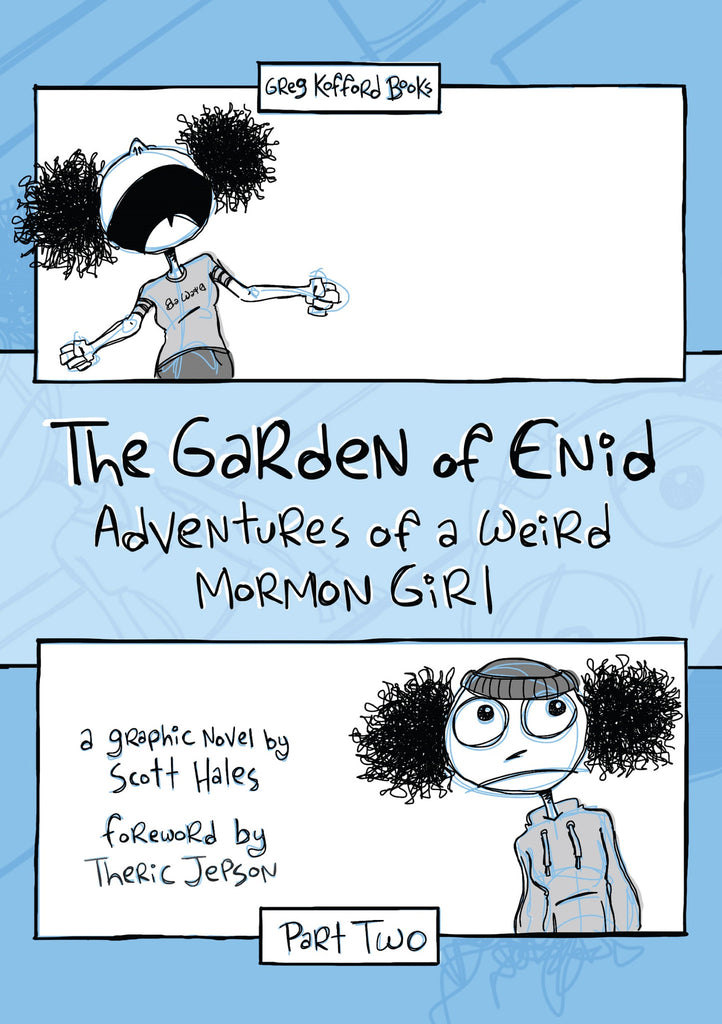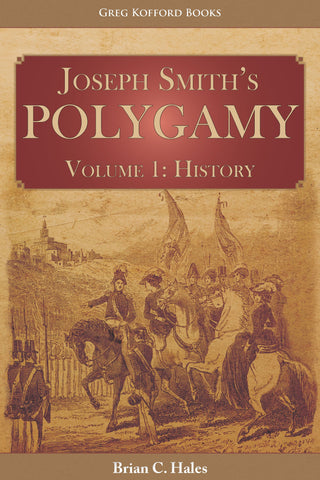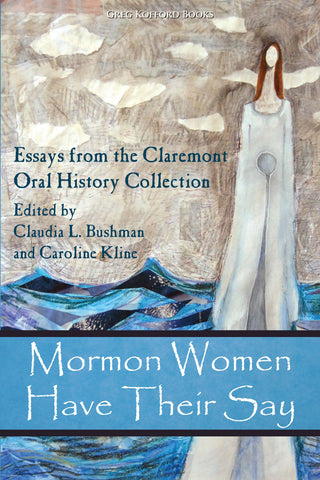The Garden of Enid: Adventures of a Weird Mormon Girl, Part Two
$22.95
by Scott Hales
with a foreword by Theric Jepson
- “Enid brings something real, something faith-affirming, something beyond Happy Valley and seminary videos and Saturday’s warrior to the LDS audience.”
- “This book is a classic whether you rush through it from cover to cover or linger over each moment.”
- “Hales has created a world that will be an enduring addition to Mormon Literature. Don't miss this delightful work.”
- “Like any good comic character, she makes me laugh. Like only a few manage to pull off, she makes me cry, too.”
Also available through Amazon.
Download a free sample preview.
Book Description:
Fifteen-year-old Enid Gardner is a self-proclaimed “weird Mormon girl.” When she isn’t chatting with Joseph Smith or the Book of Abraham mummy, she’s searching for herself between the spaces of doubt and belief. Along the way, she must grapple with her Mormon faith as it adapts to the twenty-first century. She also must confront the painful mysteries at the heart of her strained relationship with her ailing mother.
This edition of The Garden of Enid: Adventures of a Weird Mormon Girl recasts the award-winning webcomic as a two-part graphic novel. With revised and previously unpublished comics, it features the familiar story that captivated thousands online, yet offers new glimpses into Enid’s year-long odyssey.
AuthorCast interview with the Author:
Q&A with the Author:
.
Q: What are some of the themes that pop up in part 2?
A: As I was writing The Garden of Enid, I was interested in unpacking ideas about faith, history, human connection, and truth. Part two is especially interested in truth—one of the slipperiest words in language and Mormonism. For much of the book, Enid is trying to anchor herself to some kind of monolithic notion of truth. She wants to finds something stable in the universe, but she finds that the closer she thinks she gets to monolithic truth, the less monolithic it appears.
I think her journey encourages readers to reflect on the value of truth and how they want it to function in their own lives.
Q: Cameos played a big role in part 1. Who are some of the cameos that we can expect in part 2?
A: Joseph Smith continues to make cameos in part two, as do Eliza R. Snow, Evan Stephens, and the Book of Abraham mummy. Enid also talks with people like Jane Austen, Karl Maeser, Doctor Philastus Hurlbut, Charles Anthon, George A. Smith, and Juanita Brooks. The lost 116 pages and Joanna Brooks’ Book of Mormon Girl also make appearances.
Some of my favorite cameos in part two involve fictional or mythological figures from pop culture. Enid talks with Matt and Mandy from The Friend magazine, Big Foot, and Charlie Brown.
The most significant cameo in the book, however, is the late Mormon scholar Eugene England, who dresses like the Angel Moroni and acts like Virgil in Dante’s Divine Comedy. Unlike other cameo characters, who always show up in simple four-panel comics, Eugene takes Enid on a five-page odyssey through space and time, belief and doubt.
Q: How does her relationship with her mother develop in part 2?
A: The relationship becomes much rockier in part two. Enid looks to her mother’s past for answers about her own identity, but she often goes about it the wrong way. She and her mother have a traumatic falling out, and much of the book is about what happens after their relationship hits the fan. In both books, Enid struggles to see her mother as a real person, which causes her to say and do hurtful things to her mother. In part two, things go from bad to worse, but they also get better in unforeseen ways.
Q: What do you think Enid learns about herself in part 2?
A: At the end of part one, Enid begins to see herself as someone who is capable of having meaningful relationships with other people. In part two, she learns that cultivating such relationships makes her vulnerable to the raw emotions that define human experience. This make her a much more awkward and vulnerable character than the weird Mormon girl we saw in part one, but it also makes her more endearing and relatable. Her heart gets much bigger in part two.
Q: What are some of the challenges you have felt in writing this story?
A: Writing Enid’s story rarely felt like a challenge. Perhaps my biggest challenge was never letting my natural reserve get in the way of her audacity. Enid and I share many of the same interests, but we have different temperaments. Maybe that’s why I found her story so easy to write.
Of course, many of the comics touch on controversies within Mormonism, and addressing them with sensitivity was sometimes a challenge. Some satirists like to aggravate wounds, but my satire is meant to sting like antiseptic.
Q: What do you hope readers will take away from Enid’s life?
A: I hope people will read Enid and decide to stop being sucky to each other. In other words, I hope Enid’s life brings about world peace and better music on the radio.
I also hope people will read Enid and be inspired to tell stories of their own. Mormonism is an inexhaustible landscape for creative people. I hope better writers and artists than me will read Enid and want to draw on their own experiences with Mormonism to tell stories that enrich our understanding of and appreciation for the Mormon landscape.
Q: Will there be a part 3? There has to be a part 3. I mean, there really, really has to be a part 3.
A: Part three is always a possibility. I have an idea for a comic about Enid’s last summer before she goes to college. The Garden of Enid has always unfolded in real time, however, and I don’t know if I have the time this summer to do that with this story. I’ll probably start drawing it anyway to see where it goes. If I end up showing Enid as a freshman in college, so be it. I’m sure it will be awkward.
But I don’t plan to start a part three until I finish my current serial comic, Chronicles of Wyler, which is a kind of spin-off prequel to The Garden of Enid. Readers of The Garden of Enid: Adventures of a Weird Girl, Part One know Wyler from Enid’s EFY experience. Chronicles of Wyler tells the story, more or less, of how Wyler got to EFY. I’m almost finished with it, but one Wyler comic takes about three times longer to draw than an Enid comic—and I have much less time to devote to it than I had when I was drawing Enid comics all the time.
Chronicles of Wyler is a different reading experience than The Garden of Enid, and has a much smaller fan base, but I think readers who like Enid will like Wyler’s story as well.
The Garden of Enid: Adventures of a Weird Mormon Girl, Part One
Praise for The Garden of Enid:
“Enid is one of my favorite figures in Mormon culture. She is incredibly human for all of her two dimensions. On one hand, she’s a flawed yet faithful individual constantly seeking after truth. On the other, she offers a remarkable window into the life of a teen-aged girl growing up Mormon. Creator Scott Hales uses his medium to his advantage, giving The Garden of Enid a marvelous glint of theatricality. Enid bends time and space to chat with an array of characters, from the Prophet Joseph to a less historical but no less compelling guardian angel named Eugene. It’s all just a little wacky—and yet completely true and relatable” — Melissa Leilani Larson, writer of Pilot Program and Freetown
“Scott Hales [is] the cartoonist for this generation, who gets us like no one else does. . . . Enid wants to believe the gospel—and she does, more deeply than she realizes—but she is coming of age in a skeptical time, challenging her Seminary teacher and her Young Women leaders in ways they are not always prepared to deal with. She is awkward, she is vulnerable, yet when she follows her heart she invariably does the right thing.” — Ardis E. Parshall, Keepapitchinin
“Comics are always meant to help us take a look at ourselves and laugh—something sorely needed in Mormon Culture. Enid, with her wise-aleck streak, her unusual and difficult home life, and her overly developed brain, is no usual Mormon fifteen year old girl. With late-night imaginary conversations with long-dead prophets, well-told moments of loneliness and self doubt, snarky Sunday-class encounters, vulnerable, tense conversations with her closeted best friend, to midnight faith crises, Enid brings something real, something faith-affirming, something beyond Happy Valley and seminary videos and Saturday’s warrior to the LDS audience.” — Sarah Dunster, author of Lightning Tree and Mile 21
“I feel lucky to have lived at the time The Garden of Enid was being published, because it gave me the chance to meet one of the best characters in Mormon fiction. From the beginning, she's sharp, sardonic, and frighteningly straightforward—it was hard to know whether to be amused or intimidated by this self-proclaimed weird Mormon girl. But she's so delightfully unassuming, it wasn’t long before she drew me in. Enid made me wonder what it’s like to fly through the cosmos as an unorganized intelligence, made me think about what God wonders when he lies in bed at night, and taught me how to make it through Girls’ Camp safely. Get to know her: this book is a classic whether you rush through it from cover to cover or linger over each moment, as the original readers did, at a pace of a few comics a week.” — James Goldberg, author of The Five Books of Jesus
“I’m at a loss how to convey how deeply The Garden of Enid: Adventures of a Weird Mormon Girl affected me. Enid is witty, insightful, ardent, and captures many of the particular and quirky aspects of Mormonism. More than that, I found myself drawn into this fully realized character in unexpected ways. Her wholehearted engagement with life as she tries to find her place in the world had me rooting for her success over and over. I ended up genuinely caring about Enid and her story. Hales has created a world that will be an enduring addition to Mormon Literature. Don't miss this delightful work.” — Steven L. Peck, author of A Short Stay in Hell and The Scholar of Moab
“They told us we were a chosen generation. And now I know why: We get to read The Garden of Enid! Your Mormon nerd cred is directly proportional to how many of these cartoons you laugh at. The Garden of Enid has it all: laughs, esoterica, faith, messy hair, messy people, and messy endings. The best Mormon comic collection since Cal Grondahl and Pat Bagley.” — Stephen Carter, author of iPlates
“Enid isn’t a real flesh-and-blood Latter-day Saint, but the more you read the more you'll swear she is. Like any good comic character, she makes me laugh. Like only a few manage to pull off, she makes me cry, too.” — Blair Dee Hodges, Neal A. Maxwell Institute for Religious Scholarship
“There is much that Enid does not understand, just as there is much that I do not understand. But she makes me laugh, gives me hope for the future, and teaches me that it’s okay to be myself: a weird Mormon girl.” — Jana Riess, author of Flunking Sainthood and The Twible
“The Garden of Enid is what it is to be an American Mormon in microcosm . . . Like the best comic strips, Enid allows you to both laugh and reflect. And it’s a nice reminder that not only is God colorful, but so is life.” — Walker Wright, Worlds Without End
“Enid gives us something more unique, more heartfelt, more wonderfully obscure... yes, more intellectual, but also more soulful and universal.” — Mahonri Stewart, author of The Fading Flower and Swallow the Sun
“Readers will find strips that will make them laugh, make them cry, give them hope, and most importantly, make them think.” — Andrew Hamilton, Association for Mormon Letters
“Enid is able to affect us in such a powerful way.” — Steve Evans, By Common Consent
“Enid, a weird Mormon girl with an active imagination who is always contemplating the meaning of life as she tries understand the purpose of her existence and her place in the world, is the Calvin and Hobbes for the internet generation of Mormons.” — Andrew Hamilton, Association for Mormon Letters
“This graphic novel is a great one for parents to share with their teenagers. . . . the stories open the door for discussions on life’s trials, doubt and faith, relationships, and going through tough times with the help of friends and a great bishop.” — Gerald Smith, Millennial Star
“There is so much good to Enid, so much familiar Mormon weirdness, and yet so much that is faith promoting and heart-warming, that it would be a great read for any young woman. It’s equally great for weird Mormons of all ages.” — Angela C., By Common Consent
“Everyone feels somewhat out-of-place in their communities. Everyone has something in their life that makes them feel less than ideal. Everyone is searching for identity, for home. The relatability of Enid is what makes the comic so endearing.” — Walker Wright, Worlds Without End
“[Enid] faces hardship and heartbreak with courage . . . she is literally setting out on a quest as real as any mythic hero’s. It’s funny, it’s tender, it’s real, it’s oh-so-Mormon.” — Ardis Parshall, Keepapitchinin
“Just as Calvin and Hobbs, Peanuts, and other influential comics captured a moment of societal concerns that reaches beyond the brackets of those times, Enid captures something essential about Mormonism in the early twenty-first century. . . . Kofford Books has blessed us as a community by collecting these into two volumes.”
— Steven Peck, Dialogue: A Journal of Mormon Thought 50 no. 2
“Enid’s experiences and thoughts ring true to the turmoil of any young woman; for the author, a father of four young kids, to be so in tune with the indecisiveness of teen girl years is remarkable. . . . Hales skillfully portrays the heart of a teenage girl and helps us relate to her as Enid is learning to relate to the other women in her life.”
— Brittany Long Olsen, Dialogue: A Journal of Mormon Thought 50 no. 2
About the Author:
 Scott Hales is a writer and cartoonist from Cincinnati, Ohio. He is the creator of the webcomics The Garden of Enid: Adventures of a Weird Mormon Girl and Mormon Shorts. Scott has an MA and PhD in English from the University of Cincinnati and a BA in English from Brigham Young University. He has published on American literature, comics, and Mormon fiction and poetry in various journals, including The Edgar Allan Poe Review, International Journal of Comic Art, and Religion and the Arts. He has also published fiction and comics in Dialogue: A Journal of Mormon Thought and Sunstone. Scott currently lives in Utah with his wife, Sarah, and five children.
Scott Hales is a writer and cartoonist from Cincinnati, Ohio. He is the creator of the webcomics The Garden of Enid: Adventures of a Weird Mormon Girl and Mormon Shorts. Scott has an MA and PhD in English from the University of Cincinnati and a BA in English from Brigham Young University. He has published on American literature, comics, and Mormon fiction and poetry in various journals, including The Edgar Allan Poe Review, International Journal of Comic Art, and Religion and the Arts. He has also published fiction and comics in Dialogue: A Journal of Mormon Thought and Sunstone. Scott currently lives in Utah with his wife, Sarah, and five children.
More Information:
169 Pages
ISBN 978-1-58958-563-8 (Paperback)
Published February 2017







Share this item: